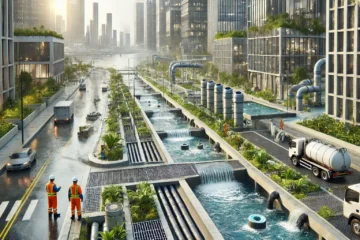High-Rise Building Safety: Key Considerations and Best Practices
High-rise buildings, with their towering presence, represent architectural marvels and serve as hubs for residential, commercial, and industrial activities. However, their height and complexity pose unique safety challenges that require comprehensive planning and robust safety measures. Ensuring the safety of occupants and infrastructure is paramount in the design, construction, and operation of high-rise buildings.
This blog explores the key aspects of high-rise building safety, common risks, and the best practices for maintaining a safe environment.
Key Safety Challenges in High-Rise Buildings
- Fire Safety
- High-rise buildings are at a higher risk of fire-related incidents due to their vertical structure, which can hinder evacuation and firefighting efforts.
- Challenges:
- Rapid smoke and fire spread through ventilation systems and stairwells.
- Difficulty in accessing upper floors during emergencies.
- Structural Integrity
- Tall structures face unique stresses due to wind forces, earthquakes, and potential impacts.
- Challenges:
- Ensuring the stability of the foundation and load-bearing elements.
- Resistance to seismic activity and high winds.
- Evacuation
- Evacuating a high-rise building during emergencies can be complex and time-consuming.
- Challenges:
- Congestion in stairwells and elevators.
- Accessibility issues for elderly or disabled occupants.
- Mechanical and Electrical Systems
- Malfunctions in elevators, HVAC systems, or power supplies can lead to safety hazards.
- Challenges:
- System failures causing entrapments or overheating.
- Maintenance difficulties due to height and complexity.
- Security Threats
- High-rise buildings can be targets for criminal activities or terrorist attacks.
- Challenges:
- Managing access control and surveillance.
- Preparing for potential threats and emergencies.
Essential Safety Features in High-Rise Buildings
- Fire Safety Systems
- Fire-Resistant Materials: Use of non-combustible materials in construction.
- Sprinkler Systems: Automatic sprinklers installed on every floor.
- Smoke Detectors: Advanced detectors connected to a central alarm system.
- Fire Escapes: Dedicated fire-resistant stairwells and escape routes.
- Structural Design
- Wind Bracing: Incorporating diagonal bracing and tuned mass dampers to counteract wind forces.
- Seismic Resilience: Flexible materials and designs that absorb seismic shocks.
- Load Distribution: Strategic distribution of loads to prevent collapse.
- Evacuation Plans
- Elevators for Emergencies: Fireproof elevators designed for evacuation purposes.
- Refuge Areas: Designated safe zones on multiple floors for temporary shelter.
- Clear Signage: Illuminated and multilingual evacuation signs.
- Mechanical and Electrical Safety
- Backup Power: Redundant power systems, including generators and UPS units.
- Elevator Safety: Emergency brakes, fire-resistant elevator shafts, and intercom systems.
- HVAC Systems: Fire dampers and smoke management systems in ducts.
- Security Measures
- Access Control: Smart card systems, biometric scanners, and visitor logs.
- Surveillance: CCTV cameras and motion detectors in common areas.
- Emergency Response Teams: On-site security and first responder teams.
Best Practices for High-Rise Building Safety
- Adherence to Building Codes
- Compliance with local and international safety standards, such as NFPA (National Fire Protection Association) codes and IBC (International Building Code).
- Regular Inspections and Maintenance
- Periodic checks of fire safety systems, elevators, and structural components.
- Routine maintenance to prevent mechanical and electrical failures.
- Emergency Drills
- Conducting regular fire and evacuation drills to familiarize occupants with safety protocols.
- Training building staff and occupants on emergency procedures.
- Advanced Technologies
- Smart Building Systems: Integration of IoT for real-time monitoring of safety systems.
- AI-Powered Surveillance: Predictive analytics to identify potential risks.
- Drones: Using drones for exterior inspections and surveillance.
- Sustainable Safety Measures
- Incorporating green building practices that enhance safety, such as solar-powered emergency systems and water-saving fire suppression technologies.
Case Studies: High-Rise Safety Innovations
- The Burj Khalifa (Dubai)
- Features state-of-the-art fire suppression systems and refuge floors every 25 levels.
- Designed to withstand extreme wind pressures and seismic activity.
- The Shard (London)
- Advanced sprinkler and smoke control systems.
- Robust security systems with 24/7 surveillance and access controls.
- Taipei 101 (Taiwan)
- Equipped with a tuned mass damper to stabilize the building during typhoons and earthquakes.
- Comprehensive evacuation plans, including high-speed emergency elevators.
The Future of High-Rise Safety
- Automation: Adoption of AI and robotics for predictive maintenance and emergency response.
- Sustainability: Integration of eco-friendly and resilient materials.
- Enhanced Collaboration: Collaboration between architects, engineers, and safety experts to design safer buildings.
Conclusion
Safety in high-rise buildings is a multidimensional challenge requiring meticulous planning, adherence to regulations, and the integration of innovative technologies. By prioritizing safety features and fostering a culture of preparedness, high-rise structures can serve as both functional spaces and safe havens for their occupants. As urbanization continues to rise, the commitment to high-rise safety becomes even more critical in ensuring the well-being of communities and the resilience of cities.


